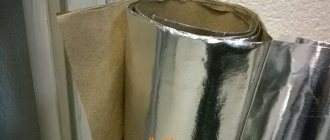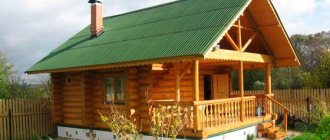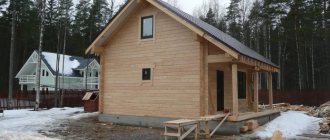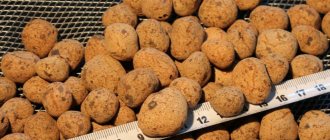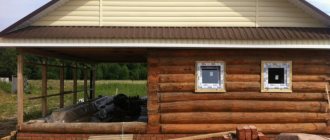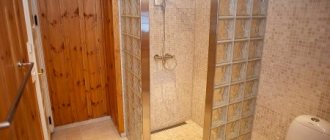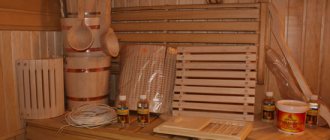Insulating a bathhouse solves the issue of accelerating warming up the interior space and maintaining comfortable warmth for a long time. The choice of thermal insulation for this purpose is a very important moment. Indeed, in addition to improved characteristics and certain advantages, the material used must be safe so as not to harm the health of visitors receiving strengthening procedures. Basalt wool is considered the best solution for insulating a bath. Let's consider working with this material in more detail.
The insulation is hidden, but its presence is felt in the level of comfort when visiting the bathhouse
Types of thermal insulation materials
To insulate a steam room, you can use various materials, from the most modern mineral wool to traditional, but ineffective insulation made from straw or expanded clay. The table provides comparisons of various insulation and building materials in terms of thermal conductivity based on the recommendations of SNiP 23–02–2003. Calculations were made for the Moscow region.
Comparison of the minimum thickness of walls and insulation
SET OF RULES. THERMAL PROTECTION OF BUILDINGS. SP 50.13330.2012. File for download
SNiP 02/23/2003
Specifically for paired rooms, the thickness of insulation is not regulated; we recommend using these data as minimum values. You can increase the thickness of insulation, but you should not reduce it.
As can be seen from the table, polystyrene foam and mineral wool are confidently in the lead in heat-saving qualities; these materials are most often used for thermal insulation of baths. What can you say about these insulation materials?
Expanded polystyrene
It has one rather unpleasant property - it releases unsafe substances into the air. Advantages - the cost of the material is much lower than that of mineral wool. In addition, it is not afraid of moisture, which makes waterproofing the insulation much cheaper and easier, and for baths this is a very important issue.
Expanded polystyrene
What do practitioners advise on the use of polystyrene foam? It can also be used indoors; a short stay in the steam room has virtually no effect on your well-being. In addition, there are modern brands that are approved by sanitary authorities for indoor use. By the way, various decorative elements for interior decoration are made from them: ceiling skirting boards, baguettes, art products, etc. However, the cost of such safe polystyrene foam is much higher.
An example of insulating a steam room floor with extruded polystyrene foam
In the case of a bathhouse, the use of polystyrene foam has another problem - rodents “love” it very much. In just one year, the slabs can turn into separate balls, and the efficiency of insulation will decrease significantly. This should also be kept in mind when choosing insulation.
Polystyrene foam requires special protection from rodents
The material can be used to insulate walls and ceilings, and expanded polystyrene with increased physical strength is also used when installing heated floors with ceramic tiles.
Water heated floor in the bathhouse
Tiles are laid on top of the heated floor
Prices for expanded polystyrene
expanded polystyrene
Mineral wool
In terms of heat-saving indicators, it is almost no different from expanded polystyrene. There are two disadvantages - high price and extremely high sensitivity to increased relative humidity. Wet cotton wool worsens the initial characteristics by an order of magnitude and causes rotting of all wooden structures.
Mineral wool - photos and characteristics
When insulating a steam room, you need to very carefully and carefully carry out construction measures for steam and water protection; this is quite expensive and time-consuming. During the construction of the bathhouse, mineral wool is used to insulate all surfaces of the steam room, except the floor.
Mineral wool is not afraid of fire, but loses its properties when wet
An example of floor insulation with two layers of mineral wool
Prices for mineral wool
mineral wool
Expanded clay
In terms of efficiency, it is significantly inferior to the above materials, but has two advantages: low cost and high versatility of use. It can be used both in bulk on the ceiling and as an additive to concrete for flooring bases.
Expanded clay
Bulk insulation also includes loose polystyrene foam. It can also be added to concrete; such a material is somewhat inferior in heat-saving characteristics to foam concrete, but surpasses it in strength. In a bathhouse, these materials can be used to insulate ceilings or make heated floors.
Expanded clay for floor insulation
Prices for expanded clay
expanded clay
Ecowool
Quite a new material, universally applicable. The price is quite satisfactory for consumers, the application technology is not difficult. It is made from recycled cellulose (waste paper) with the addition of antiseptics and fire retardants. Before mechanical application it is diluted with water; it can be used to insulate any surface. The use of ecowool is sometimes the only possible way to insulate surfaces of complex profiles; the technology of use allows for additional processing of sheathed surfaces without dismantling them.
Ecowool – packaging
Ecowool, properties
In terms of thermal conductivity characteristics, ecowool is not inferior to mineral wool, is not afraid of high humidity, is low flammable, and is not damaged by rodents.
Properties of ecowool
Suitable for insulating ceilings in bulk without diluting with water. The disadvantage is that after applying the wet material using a mechanized method, the wooden structures must dry well, and this is quite difficult for all rooms of the bathhouse.
Ecowool insulation
Traditional materials
This refers to the use of straw and sawdust to insulate ceilings. The materials are mixed with clay and diluted to the consistency of thick sour cream. Only the ceilings of the steam room can be insulated. Advantages: lowest price. Disadvantages - unsatisfactory heat saving indicators, a large amount of heavy manual work. Today, such insulation is used extremely rarely.
Natural insulation materials
Attic insulated with sawdust
Insulating the floor with a mixture of clay and sawdust
In this brief review of insulating materials, we tried to give objective characteristics, not to indicate only the positive aspects, but also not to forget about the shortcomings. And each of them has them. We hope that this will help you make informed decisions when choosing technology and materials for insulating your bathhouse, taking into account the maximum number of individual factors.
What is basalt wool
It has already been mentioned that basalt insulation belongs to the group of mineral materials. Its distinctive feature is the production raw materials used. To obtain the fibers of the future heat insulator, rock materials are used. Therefore, basalt wool is often called stone wool.
The production technology involves obtaining a liquid rock melt in a furnace at 1400-1500°C, from which fiber is drawn. Binding components are used to bind the resulting fibers into a homogeneous array. Correct selection of the binder base helps to significantly improve the characteristics of stone wool. After forming the structure, setting the direction of the layers and obtaining the required density, the finished material is cut to a standard size and packaged. Forms of release: mats, soft rolls, hard slabs.
How to insulate a steam room
Effective insulation of a steam room is a complex set of construction works. Where should you start insulating a steam room? Most will answer without hesitation: of course, from the walls, ceiling and floor. But this is not at all true, these measures should be carried out already at the second stage of insulation, and you need to start from something completely different. Why?
Windows and doors
If the steam room has a large window and even a single glass window, then heat losses will largely offset all work on insulating the walls and ceiling. In a steam room, the window should be at least one-chamber (ideally two-chamber) and small in size. Professional builders advise making a steam room without a window at all. Heat loss through a large window can be more than 20%.
It is irrational to make a large panoramic window in a steam room
Small window in the steam room - photo
Gaps in doors are the second reason for significant losses; be sure to nail rubber seals around the perimeter. Doors must be wooden, dense, the thickness of the boards is at least 35 mm.
Wooden door to the steam room
Another very important factor to pay attention to is ventilation. No matter how you insulate the steam room, the effect will be minimal if the air exchange rate in the room is too high. Ventilation is necessary, no one argues, but it should only be regulated. You should always be able to both close it completely and increase the frequency of air changes as necessary.
What types of adjustable ventilation grilles are there?
Having solved these questions, start thinking about methods and materials for insulating the floor, walls and ceiling of the steam room.
Now let’s take a look at ways to insulate a steam room.
Materials for insulating a bathhouse from the inside: what to add to your shopping list?
Buying insulation for a bath comes down not only to the ability to choose natural or artificial materials, you should also take into account some factors: the purpose of the materials, appearance and price. Depending on the mechanical properties, materials for thermal insulation can be roughly divided as follows:
- backfills of various densities;
- mats, plates, fibers;
- wall blocks and slabs.
Insulation materials are classified according to their chemical composition:
- organic (ecowool, fiberboard, wood concrete);
- inorganic (glass wool, mineral wool, basalt fiber);
- techno-insulation materials (technoblock, technovet);
- insulation materials based on plastics (expanded polystyrene, polystyrene foam).
All these materials have both advantages and disadvantages. For example, it is better not to use plastic-based insulation to insulate a steam room from the inside. This is due to their easy flammability. But they are well suited for thermal insulation of other rooms of the bathhouse: dressing room, rest room.
Organic substances, in turn, are environmentally friendly and relatively cheap, but without treatment with special means they are also highly flammable. Inorganic substances are more versatile and practical: fire-resistant, durable, moisture-proof, and not subject to rotting. This explains the popularity of using mineral wool in insulation.
Materials used for vapor barrier of the bathhouse from the inside:
- roofing felt;
- glassine;
- polyethylene;
- aluminium foil.
Roofing felt and glassine cannot be used for vapor barrier in a steam room, since under the influence of high temperatures they begin to release harmful chemicals. Glassine is often used in the insulation of baths, having proven itself well in combination with lining - aluminum foil - mineral wool - log house.
By choosing aluminum foil for the steam room vapor barrier, you will significantly reduce energy costs to maintain the required temperature. The foil, like a mirror, will reflect the heat in the bathhouse.
Insulation of steam room floors
Wooden floors do not require insulation. Even with a very strong desire, insulation will do much more harm than good. Ceramic tile floors should be insulated. How it's done?
Step 1: Prepare the base. The ground under the steam room needs to be leveled, and a sand cushion about ten centimeters thick should be poured on top.
sand cushion
Important. Before starting work, hit the zero mark. Construction zero is the level of location of the finishing flooring. Knowing this point, you can calculate the thickness of the pillow and concrete base.
Step 2. Compact the sand cushion, install plastic pipes to drain water, and lay a layer of waterproofing. For these purposes, you can use roofing felt or ordinary plastic film. Waterproofing will reduce the relative humidity of concrete, which increases its heat-saving properties.
Example of laying communications
Example of waterproofing flooring
Prices for waterproofing
waterproofing
Step 3: Prepare the concrete. We strongly recommend using foam concrete for the base or adding expanded clay or loose foam to the cement-sand mixture. To prepare the solution, add two parts sand and three parts expanded clay to one part cement.
Mixing concrete
Expanded clay concrete
Step 4. Install beacons. Water drainage can be done in the middle or in the corner of the steam room. We do not recommend the first option - it is quite difficult to perform a screed with a slope towards the center. It is enough to have a slope within 2÷3 mm per linear meter of the room. Make a bias towards the location of the shelf or doors. Make a specific decision taking into account the location of the bathhouse and the possibility of discharging water beyond its perimeter.
Floor screed with expanded clay
Step 5. If you have the desire and opportunity, you can concrete the wires for electric floor heating. If you don’t want to, wait a few days until the screed dries and start laying ceramic tiles.
Ceramic tiles in the bath
The cost of an insulated ceramic steam room floor is much higher than a wooden one. As for the comfort of taking water procedures, there is no significant difference. The only advantage is that the service life of floors under ceramic tiles is much longer than that of wood.
Tiled floors are much more durable than wood floors
Application of sawdust
Insulating the ceiling in a bathhouse with sawdust has been known for many years. This is an inexpensive method with the following advantages:
- a budget option;
- easy installation;
- long service life;
- environmental friendliness.
For the bath structure, you need to choose small sawdust obtained from coniferous trees. An ideal option for a bathhouse would be larch sawdust. The insulating layer should be 20 cm high. Large sawdust retains heat less well.
Before using sawdust, check for debris and foreign objects. Large particles of foreign inclusions will have to be selected manually.
To use sawdust as insulation for the ceiling space of a bathhouse, you need to prepare the following composition:
- dry sawdust (10 parts);
- lime (1 part);
- cement (1 part);
- antiseptic 3 tbsp. l. (borax or copper sulfate);
- water (5 or 10 parts).
First, cement and lime are mixed. The resulting mixture is added to dry sawdust, previously poured into the container. Everything is thoroughly mixed - the solution is ready for use.
Dilute the antiseptic in water using protective gloves and a mask. The resulting solution is added to the mixture with sawdust. Do not forget to constantly stir the solution during preparation. The mixture should not be too liquid. Readiness is checked this way: roll the mixture into a ball. If it does not disintegrate, then it can be used.
Sawdust insulation process:
- beam floors are stitched with boards;
- sawdust is heavy, so secure the beams well with nails;
- all wooden elements are treated with an antiseptic solution;
- part of the vapor barrier is applied. The joints are covered with tape, the voids are filled with polyurethane foam;
- sawdust should be laid out in layers, then leveled on the surface and compacted;
- the height of the sawdust layer should reach the top floor;
- You can sprinkle a little ash on top of the sawdust, which will protect against insects;
- after spreading the sawdust, leave the structure until completely dry (up to 3 weeks);
- another piece of vapor barrier material. The result is an envelope effect: there is sawdust inside, and a vapor barrier layer on the sides.
If in the future you plan to use the attic space as a room, then make a cement screed on top of the structure.
Insulation of steam room walls
Insulation can be done with pressed or rolled mineral wool, polystyrene foam or ecowool. It is quite difficult to give unambiguous advice; there are too many different factors. Most often, mineral wool is used for these purposes; to facilitate the waterproofing process, it is better to immediately purchase foil wool. True, it costs more than usual. But, if you take into account the additional costs of waterproofing, including loss of time, then the money invested is well worth the investment.
Foil basalt insulation
As for the thickness of thermal insulation. Comparing the data available in the tables gives nothing to many developers. We recommend using two criteria: the climate zone of residence and the time of use of the steam room. If the bathhouse is located in areas with very low temperatures, then the thickness of the wool should be at least 10 cm. For milder climates, it is enough to insulate with wool 5 cm thick.
Rockwool Insulation
If the steam room is used for a short period of time, the heat will be retained by a thinner layer of insulation. When people will be in the steam room for several hours, then put insulation at least 10 cm thick. But these are general recommendations, choose the specific values yourself.
Let's consider the algorithm for performing work on insulating walls with rolled foiled mineral wool 10 cm thick.
Step 1. Check the walls of the room, mark the installation of vertical mounting rails. The width of the slats should be equal to the thickness of the mineral wool. Nail the two outer slats and check their verticality with a level. If necessary, use various pads under the slats to give them a vertical position.
Advice from professionals. If the thickness of the mineral wool should be 10 cm, then difficulties arise with attaching slats of this size. We recommend using metal corners; with their help you can not only quickly fix the supporting frame, but also adjust the vertical position. In addition, you can use narrow material. For one slate, 3–4 corners are quite enough.
Example of fixed sheathing over foil insulation
Lathing installation diagram
It is possible to replace wooden slats with metal slats made of galvanized sheet steel, but they will cost much more.
Metal profile lathing
Metal lathing - option for mounting on hangers
Step 2. Stretch ropes between the outer slats and nail the remaining slats along them. Check their position constantly. The distance between them should be 1÷2 cm less than the width of the roll or sheets of pressed mineral wool. Do the same work around the entire perimeter of the steam room.
Step 3. Prepare the lining, bring it indoors and let it sit for several days. For a steam room, we strongly recommend using European profile lining.
Eurolining profiles
- Firstly, it has increased tenon/groove dimensions, which eliminates the appearance of cracks during swelling/drying of the material.
- Secondly, the rear plane of the eurolining has a recess - drying conditions are much improved.
You can nail the lining both into the groove and into the front plane. The first method is more beautiful, but requires some skill, the second method is simpler, but the heads of the hardware will be visible. It is better to use galvanized or copper nails.
Step 4. Start laying insulation between the slats, making sure there are no gaps or gaps. Mineral wool is fixed with special hardware with large heads. If you don’t have them, make your own hats from thin sheet steel.
Insulation of walls with mineral wool
Advice from professionals. We recommend using foiled mineral wool for insulation. It costs more than usual, but the difference pays off. There is no need to purchase additional materials for waterproofing and the time required to complete the work is significantly reduced.
Step 5: Seal the seams between the joints. To do this, you can use special self-adhesive aluminum foil or ordinary tape. It makes no difference what material you choose. The main thing is to completely exclude the possibility of penetration of moist air into the thickness of the mineral wool.
Step 6. Attach the slats for fastening the lining, the thickness of the slats is approximately two centimeters. Due to these slats, natural ventilation of the casing will be possible. Leave gaps of 1÷2 cm between the floor and ceiling for ventilation. The cracks will then be covered with ceiling and floor plinths and will become invisible.
Lathing for lining
Fastening eurolining with clamps
Cladding the wall with clapboard
If all the requirements of insulation technology are met, the thermal insulation of the walls will be effective and durable.
The installation process of basalt insulation
Wooden log houses for baths do not require additional internal insulation. And in cases where other building materials and construction technologies are used, the thermal insulation process differs.
Insulation of walls in block buildings
The walls of a bathhouse made of brick and other artificial block-type stone are insulated according to the general scheme. We list the main stages of work:
- A frame is pre-mounted on the wall with a spacing of beams or profiles, ensuring dense laying of the wool slabs between them.
- Insulation boards are placed into the finished frame. For reliability, they can be secured with umbrella-type dowels.
- Any noticed cracks and gaps are sealed using polyurethane foam.
- Over the entire area, the walls are laid with an overlap of vapor barrier fabric (preferably foil). The joints are taped with special tape.
- If the frame and basalt wool are the same thickness, add an additional sheathing of thin strips on top of the beams to create a ventilation gap.
- The internal lining of the steam room is made with wooden clapboard. Aspen wood has minimal thermal conductivity and is traditionally used for this purpose.
Illustration of “pie” layers for internal insulation of bathhouse walls
Block materials, especially lightweight porous concrete, are hygroscopic. Their external protection will also be required.
More information about working with basalt wool:
Insulation of frame baths
Prefabricated frame baths do not require large investments and labor costs, therefore they are in high demand. With high-quality insulation, they are practically not inferior to log steam rooms. To fill the openings between the elements of the wooden frame, basalt wool with a thickness of up to 15 cm is used.
Step-by-step insulation process:
- Installation of film hydro-wind protection from the outside of the frame.
- Laying stone wool.
- Protection of the insulation from the inside with a vapor barrier material (possibly with a foil surface).
- Covering the frame with wooden clapboard on both sides.
- Treatment of external cladding with protective impregnations or painting.
Bath frame with external waterproof film
The versatility of natural basalt wool has been proven by the practice of insulating any structural elements of a building made from various building materials with its help. Thanks to its unique characteristics, environmental friendliness and safety for humans, it has deservedly become a win-win, optimal option for internal insulation of a bathhouse.
Thermal insulation of the steam room ceiling
Ceilings can be insulated with polystyrene foam, mineral wool, ecowool, expanded clay or straw with clay. The best option is mineral wool. The algorithm for insulating ceilings with mineral wool is no different from the work on arranging walls; there is no point in repeating it. Let's talk about another method using expanded clay. Insulation is carried out after the finishing of the steam room ceiling. Expanded clay thickness is at least twenty centimeters.
Insulation of a bathhouse ceiling using expanded clay
Important. Expanded clay is hygroscopic and can increase its weight several times when saturated with moisture. This has a very negative effect on load-bearing surfaces; there are cases of deformation of the ceiling cladding. To avoid such an unpleasant phenomenon, carefully make hydro- and vapor barriers.
Step 1. Lay vapor barrier material on the ceiling. For these purposes, you can use both ordinary cheap polyethylene film and expensive modern non-woven materials.
Ceiling vapor barrier
Practical advice. We recommend taking film for several reasons. Firstly, there is cost. Secondly, the efficiency is almost in no way inferior to the widely advertised nonwoven materials. Thirdly, it is possible to make the insulation completely continuous without joints. The film is sold in rolls; the manufacturing method makes it possible to obtain a continuous sleeve. The width of the roll can exceed three meters; in cross-section it will be six meters wide. This means that all individual rooms of the bathhouse can be insulated with a continuous film. Fourthly, there is a wide choice of material in thickness. For ceilings, it is better to buy a sleeve with a thickness of at least 35 microns.
Laying and installation of vapor barrier on the ceiling
Ceiling vapor barrier
Step 2. Carefully pour a layer of expanded clay at least 20 cm thick onto the film in an even layer. Cover the top with film.
Sprinkled expanded clay
Expanded clay covered with vapor barrier
We need to say a few words about how expanded clay works. Among its shortcomings, none of the manufacturers mention one quite significant one. Air passes through it almost without resistance, the large diameters of the individual balls create significant free spaces between them. Since air passes almost freely, heat loss due to convection increases significantly and, accordingly, the effectiveness of thermal insulation deteriorates. After covering the expanded clay on top, efficiency improves - warm air does not have the opportunity to escape from the insulator.
What is expanded clay
It’s good that expanded clay is covered, the ceilings retain heat better, but another danger arises. The material can absorb a large amount of moisture; wet insulation not only worsens the initial thermal conductivity, but also becomes much heavier. And this threatens to increase the load on all structural elements of the ceiling, and there is a risk of their deformation or complete loss of stability. Experienced builders recommend opening the top film at least once a year for several days to ventilate and dry the expanded clay.
It is recommended to periodically ventilate the expanded clay mound.
Work on insulation with straw and sawdust is almost no different from that described with expanded clay. But there are a few additional negative points. The first is that the weight of the insulating layer increases significantly. Second, the clay is liquid; it takes time and conditions for the water to dry. Third - the thickness of the ceiling boards must be at least 35 mm. The fourth is the low efficiency of this method of insulation.
Practical tips for insulating a steam room
It is very difficult to find rooms in any buildings in which building structures and materials would be used in such difficult conditions: high humidity and temperature, direct contact with water, the presence of multidirectional splashes, large temperature differences in certain areas of the walls and ceiling. In this regard, we strongly recommend that you do not rush during the work and do not try to skip some technological operations in order to save time and money.
This is a virtual saving; theoretical expectations to reduce construction costs in most cases become the cause of very real losses. And a decrease in the comfort of taking water procedures is not the biggest nuisance.
Steam room and its internal arrangement
Carry out all insulation work as a whole, paying equal attention to ceilings, walls and floors. Don't forget that thermal insulation includes reducing losses through windows and doors, do it correctly and use ventilation. The choice of methods, materials and methods of thermal insulation of the steam room should be made consciously and taking into account both all the architectural features of the bathhouse and the modes of use of the steam room.
An insulated steam room is the key to comfort and fuel economy
Benefits of the procedure
If the task is to thermally insulate a bathhouse from the inside with your own hands, you should first find out how to insulate this structure correctly. This will avoid many mistakes. This method, according to experts, is the most reliable. It allows:
- Increase the service life of premises.
- Eliminate the need for frequent bath repairs.
After creating a layer of insulation from mineral wool or polystyrene foam, the consumption of solid fuel when heating rooms is reduced. If you use modern materials during an event, a comfortable atmosphere will appear in the washroom and other rooms.
In this video we will learn about the process of insulating a bathhouse:
Very rarely, a bathhouse on a country site is a log house with a traditional brick stove inside. Most often this is a frame-type structure made of wood or a building made of concrete. To quickly warm up rooms, you cannot do without an insulating layer. If you refuse to create it, the rooms will cool down in a short time.
The thermal insulation procedure for a bath has certain advantages. Experts identify the following as the main ones:
- Proper insulation of the steam compartment provides an opportunity to save resources. The optimal temperature in the steam room occurs within a short period.
- If the event is carried out correctly in the dressing room and in the shower, the owner will not worry about the uncomfortable atmosphere in these rooms when receiving couple procedures.
- If we exclude deviations from the technology when creating an insulating layer, then with further use of the structure, the circulation of moisture and steam inside the bath will occur in the correct way. As a result, they will be prevented from settling on the facing material and on the walls. This means that the wooden structural elements will not rot.
It should be said that you should not use a bathhouse for its intended purpose if there is fungus or mold on the walls. This negatively affects your health and can lead to asthma. In addition to this, walls with such decoration look unattractive.
